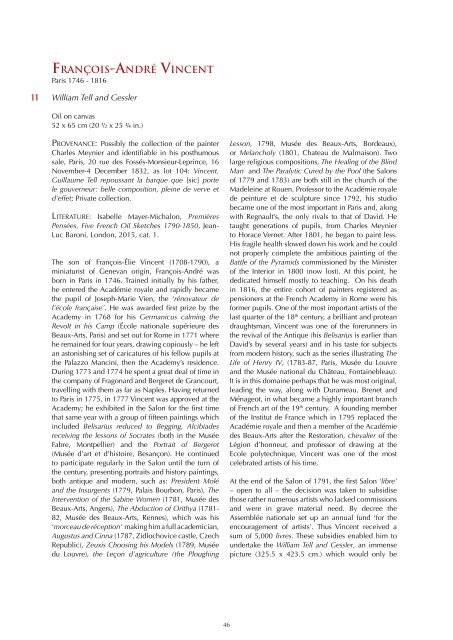You also want an ePaper? Increase the reach of your titles
YUMPU automatically turns print PDFs into web optimized ePapers that Google loves.
François-André Vincent<br />
Paris 1746 - 1816<br />
11<br />
William Tell and Gessler<br />
Oil on canvas<br />
52 x 65 cm (20 ½ x 25 ¾ in.)<br />
Provenance: Possibly the collection of the painter<br />
Charles Meynier and identifiable in his posthumous<br />
sale, Paris, 20 rue des Fossés-Monsieur-Leprince, 16<br />
November-4 December 1832, as lot 104: Vincent.<br />
Guillaume Tell repoussant la barque que [sic] porte<br />
le gouverneur: belle composition, pleine de verve et<br />
d’effet; Private collection.<br />
Literature: Isabelle Mayer-Michalon, Premières<br />
Pensées, Five French Oil Sketches 1790-1850, <strong>Jean</strong>-<br />
<strong>Luc</strong> <strong>Baroni</strong>, London, 2015, cat. 1.<br />
The son of François-Élie Vincent (1708-1790), a<br />
miniaturist of Genevan origin, François-André was<br />
born in Paris in 1746. Trained initially by his father,<br />
he entered the Académie royale and rapidly became<br />
the pupil of Joseph-Marie Vien, the ‘rénovateur de<br />
l’école française’. He was awarded first prize by the<br />
Academy in 1768 for his Germanicus calming the<br />
Revolt in his Camp (École nationale supérieure des<br />
Beaux-Arts, Paris) and set out for Rome in 1771 where<br />
he remained for four years, drawing copiously – he left<br />
an astonishing set of caricatures of his fellow pupils at<br />
the Palazzo Mancini, then the Academy’s residence.<br />
During 1773 and 1774 he spent a great deal of time in<br />
the company of Fragonard and Bergeret de Grancourt,<br />
travelling with them as far as Naples. Having returned<br />
to Paris in 1775, in 1777 Vincent was approved at the<br />
Academy; he exhibited in the Salon for the first time<br />
that same year with a group of fifteen paintings which<br />
included Belisarius reduced to Begging, Alcibiades<br />
receiving the lessons of Socrates (both in the Musée<br />
Fabre, Montpellier) and the Portrait of Bergeret<br />
(Musée d’art et d’histoire, Besançon). He continued<br />
to participate regularly in the Salon until the turn of<br />
the century, presenting portraits and history paintings,<br />
both antique and modern, such as: President Molé<br />
and the Insurgents (1779, Palais Bourbon, Paris), The<br />
Intervention of the Sabine Women (1781, Musée des<br />
Beaux-Arts, Angers), The Abduction of Orithya (1781-<br />
82, Musée des Beaux-Arts, Rennes), which was his<br />
‘morceau de réception’ making him a full academician,<br />
Augustus and Cinna (1787, Zidlochovice castle, Czech<br />
Republic), Zeuxis Choosing his Models (1789, Musée<br />
du Louvre), the Leçon d’agriculture (the Ploughing<br />
Lesson, 1798, Musée des Beaux-Arts, Bordeaux),<br />
or Melancholy (1801, Chateau de Malmaison). Two<br />
large religious compositions, The Healing of the Blind<br />
Man and The Paralytic Cured by the Pool (the Salons<br />
of 1779 and 1783) are both still in the church of the<br />
Madeleine at Rouen. Professor to the Académie royale<br />
de peinture et de sculpture since 1792, his studio<br />
became one of the most important in Paris and, along<br />
with Regnault’s, the only rivals to that of David. He<br />
taught generations of pupils, from Charles Meynier<br />
to Horace Vernet. After 1801, he began to paint less.<br />
His fragile health slowed down his work and he could<br />
not properly complete the ambitious painting of the<br />
Battle of the Pyramids commissioned by the Minister<br />
of the Interior in 1800 (now lost). At this point, he<br />
dedicated himself mostly to teaching. On his death<br />
in 1816, the entire cohort of painters registered as<br />
pensioners at the French Academy in Rome were his<br />
former pupils. One of the most important artists of the<br />
last quarter of the 18 th century, a brilliant and protean<br />
draughtsman, Vincent was one of the forerunners in<br />
the revival of the Antique (his Belisarius is earlier than<br />
David’s by several years) and in his taste for subjects<br />
from modern history, such as the series illustrating The<br />
Life of Henry IV, (1783-87, Paris, Musée du Louvre<br />
and the Musée national du Château, Fontainebleau).<br />
It is in this domaine perhaps that he was most original,<br />
leading the way, along with Durameau, Brenet and<br />
Ménageot, in what became a highly important branch<br />
of French art of the 19 th century. A founding member<br />
of the Institut de France which in 1795 replaced the<br />
Académie royale and then a member of the Académie<br />
des Beaux-Arts after the Restoration, chevalier of the<br />
Légion d’honneur, and professor of drawing at the<br />
Ecole polytechnique, Vincent was one of the most<br />
celebrated artists of his time.<br />
At the end of the Salon of 1791, the first Salon ‘libre’<br />
– open to all – the decision was taken to subsidise<br />
those rather numerous artists who lacked commissions<br />
and were in grave material need. By decree the<br />
Assemblée nationale set up an annual fund ‘for the<br />
encouragement of artists’. Thus Vincent received a<br />
sum of 5,000 livres. These subsidies enabled him to<br />
undertake the William Tell and Gessler, an immense<br />
picture (325.5 x 423.5 cm.) which would only be<br />
46
















